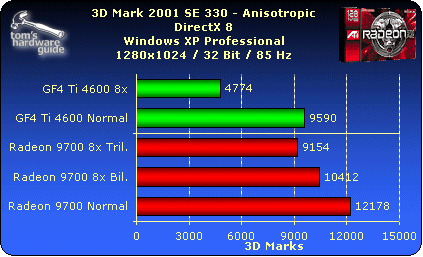ATi Radeon 9700 PRO - Pretender To The Throne
Anisotropic Filtering
Anisotropic filtering is a technique that makes textures look cleaner and crisper on objects when viewed at a very small angle. More details can be found here . Radeon 9700 allows for anisotropic filtering with either a bilinear or a trilinear filter. NVIDIA, on the other hand, offers only the trilinear filtering mode, which produces better quality with the drawback of being more performance-intensive. Both cards were set to filtering level 8x.
ATi's implementation uses a couple of tricks to lighten the burden on the GPU and improve performance. For example, the level of filtering used is automatically adjusted depending on the angle at which an object is viewed. This is a pretty smart idea, since lower (and, thus, faster) filtering levels are often sufficient at smaller viewing angles. Of course, NVIDIA has a different take on this, and the debate on which implementation is better is currently in full swing. At the moment, the only way to tell any difference between the two methods is to take screenshots and go over them with a magnifying glass. (It also helps if you squint. Oh well.) In a real-world environment while a game is in progress, it is unlikely that a user would be able to tell the difference. Once again, the Radeon's good results are also due in large part to the eight pixel pipelines.
3D Mark 2001 SE 330 - Anisotropic



ATi's anisotropic filtering implementation proves to be superior, thanks to the eight pixel pipelines, of course.
Stay On the Cutting Edge: Get the Tom's Hardware Newsletter
Get Tom's Hardware's best news and in-depth reviews, straight to your inbox.
Current page: Anisotropic Filtering
Prev Page 3D Mark 2001 SE 330 - FSAA - Dragothic Next Page 3D Mark 2001 SE 330 - Anisotropic - Dragothic